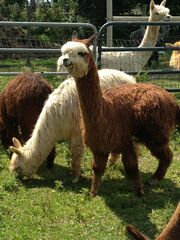
3 of my Suri Alpacas, and their desirable coats.
Domestic Camelids[]
A study published in Science recently outlined new research in the evolution of domestic dogs, however canines are not the only animals to undergo change during the process of domestication, plants and many animals are now domesticated. Certain characteristics make a plant or animal desirable for domestication. For example, a wild-type plant may exhibit a smaller seed or fruit than that of a close cousin, but that close cousin may contain a toxin that requires extra processing before the food source can be consumed, the smaller fruited plant will be the first to be domesticated (Diamond, 2000). In the same way New World Camelids, the alpaca and the llama are both domestic varieties of wild cousins.
Why they were domesticated[]
The strong build of the llama, and the fine, medullated fibers of the alpaca are two characteristics that made their wild cousins desirable for domestication. The llama, although the fiber is still warm, is strong and almost double the size of the alpaca, it's surefootedness makes it an ideal canidate for a pack animal in the andes mountains. Alpacas, weighing only 150 lbs when full grown, produce fine fleece, which is an excellent insulater, and makes them ideal for domestication as well. Both alpacas and llamas eat very little, and are highly productive in their respective fields (Wheeler, 1995).
Diamond, J. (2002). Evolution, consequences and future of plant and animal domestication. Nature, 418(6898), 700-707.
Wheeler, J. C. (1995). Evolution and present situation of the South American Camelidae. Biological Journal of the Linnean Society, 54(3), 271-295.